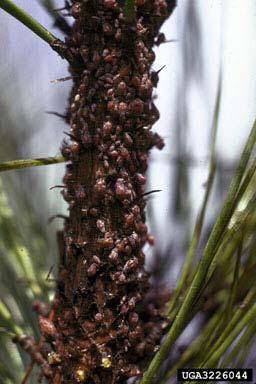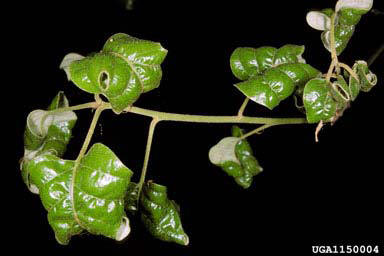
Importance: In Alabama, aphids, also known as plant lice, are not considered forest pests. Serious damage sometimes results, especially to shade and ornamental trees and young trees in plantations. They can attack all pines and hardwoods. Distorted, curled, and yellowing needles and leaves often result, along with reduced tree vitality and possible branch or tree mortality. Honeydew dropping from heavily infested trees is a nuisance as it forms a sticky coating on everything below. It detracts from aesthetic values of trees, and interferes with proper functioning of their leaves.
Identification: Adult aphids may or may not have wings. The wings are very delicate and membranous, and usually held vertically above the body while at rest. Both adults and nymphs are soft bodied, pear-shaped insects with long antennae. Aphids have sucking mouthparts that arise from the back of the head and point downward. They vary in size from 1/32 to 1/4 inch in length and may be white, green, yellow, black, gray or brown in color. Nymphs look like adults, but are smaller. Eggs are dark colored and large, considering the size of the adults.
Signs of Attack: Usually the first sign of attack is large numbers of aphids on the tree or branch. They excrete massive amounts of sweet sticky honeydew that attracts great numbers of ants. Sooty mold often develops on the honeydew, and branches, trees or lower leaves may appear black. Stunted growth of twigs, and curled and distorted leaves are also indicative of aphid attack.

Life Cycle: Winged female aphids fly to a host tree or plant and start a new colony. Young are usually born alive, although eggs may be laid. Most young are female and mating is not necessary for reproduction. A female may produce as many as 100 offspring in her lifetime. Nymphs feed on plant juices and mature in approximately one week. There are many generations per year and both nymphs and adults are present at any time during the year.
Control: Natural enemies take their toll on these insects but usually there is damage to the host tree before that occurs. Forest control: No chemical control recommended. Shade tree control: An insecticide application may be used to protect valuable shade trees. Spray tree with 0.25% malathion (mix 3 1/4 pints of 57% malathion EC with 100 gallons of water; or one tablespoon per gallon according to label directions and state laws). excellent fish bait.
Photo Credit: Andrew J Boone, South Carolina Forestry Commission, ForestryImages.Org
Additional Resources